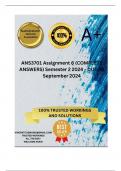, ANS3701 Assignment 6 (COMPLETE ANSWERS) Semester
2 2024 - DUE 30 September 2024 ; 100% TRUSTED
Complete, trusted solutions and explanations.
Question 1 In conservation genetics, heterozygosity is a
fundamental measure of genetic diversity within a population.
For example, if a population of leopards has an observed
heterozygosity (Ho) of 0.35, this means 35% of individuals
possess different alleles at a given genetic locus. In comparison,
expected heterozygosity (He) represents the level of genetic
variation expected under random mating, and a much higher He
value of, for example, 0.52 would indicate potential inbreeding
or genetic drift, thus reducing diversity in this population. The
inbreeding coefficient (Fis) quantifies the extent of inbreeding,
with values closer to 1 suggesting higher levels of inbreeding. If
a population of leopards shows a Fis of 0.33, it points to a
significant reduction in genetic diversity compared to a
connected population with a lower Fis of, for example, 0.05.
When populations experience events like genetic bottlenecks,
where population numbers decrease drastically, allele
frequencies become skewed, resulting in reduced allelic richness
(i.e. the number of alleles per locus). This can be detected
through genetic tests like the M-ratio, where a low value may
signal the effects of a bottleneck. 2 Effective population size
(Ne) refers to the number of individuals contributing to the next
generation's gene pool (i.e., the number of reproductive
individuals in a population) and is often lower than the censused
population size due to factors like unequal sex ratios or varying
reproductive success. For example, if a population census size is





